Traditions, Spirit and History
Established in 1910 as a teacher-training institution, Bowling Green held its first classes in 1914, but it was not until the following year that the first two buildings--now University Hall and Williams Hall--were ready for use. Student enrollment for that initial year totaled 304, with a faculty of 21. The first bachelor's degrees were awarded in 1917.
In 1929, the functions of Bowling Green were expanded to provide four-year degree programs in the College of Education and the College of Liberal Arts. The Schmidthorst College of Business and graduate programs were added in 1935, the year in which Bowling Green attained full university status. In 1947, the Graduate School was formed, and BGSU awarded its first doctorate in English in 1963.
Beginning in 1946, extension programs of the university were offered in Sandusky, Ohio. During the next two decades, course offerings there were expanded and in 1965 a regional campus of the University was established to serve Erie, Huron and Ottawa Counties. That campus is now Firelands College, located in Huron, Ohio. Firelands College, which opened for classes in 1967, offers career and technical education leading to associate degrees in 15 areas as well as eight bachelor's degree programs.
In the 1970s, three new colleges were added to the University's curricular offerings. In 1973, the College of Health and Human Services was established to provide degree programs in specialized areas in various health and community service fields. In 1975, the School of Music was expanded into the College of Musical Arts, and in the same year the Graduate School became the Graduate College. The School of Technology was granted college status in 1985.
School Colors
The history behind how BGSU began using brown and orange as its school colors dates back to 1914. Dr. Homer B. Williams, the University’s first president, gathered a group of people, including Dr. Leon L. Winslow, from the industrial Arts department, as a selection committee for the school’s new colors. While on a trolley ride to Toledo, Dr. Winslow sat behind a woman wearing a large hat adorned with brown and orange feathers. He was so impressed by the color scheme that his committee recommended to the Board of Trustees they approve the combination of burnt orange and seal brown.
Today, BGSU is the only Division I university to have orange and brown as its school colors.
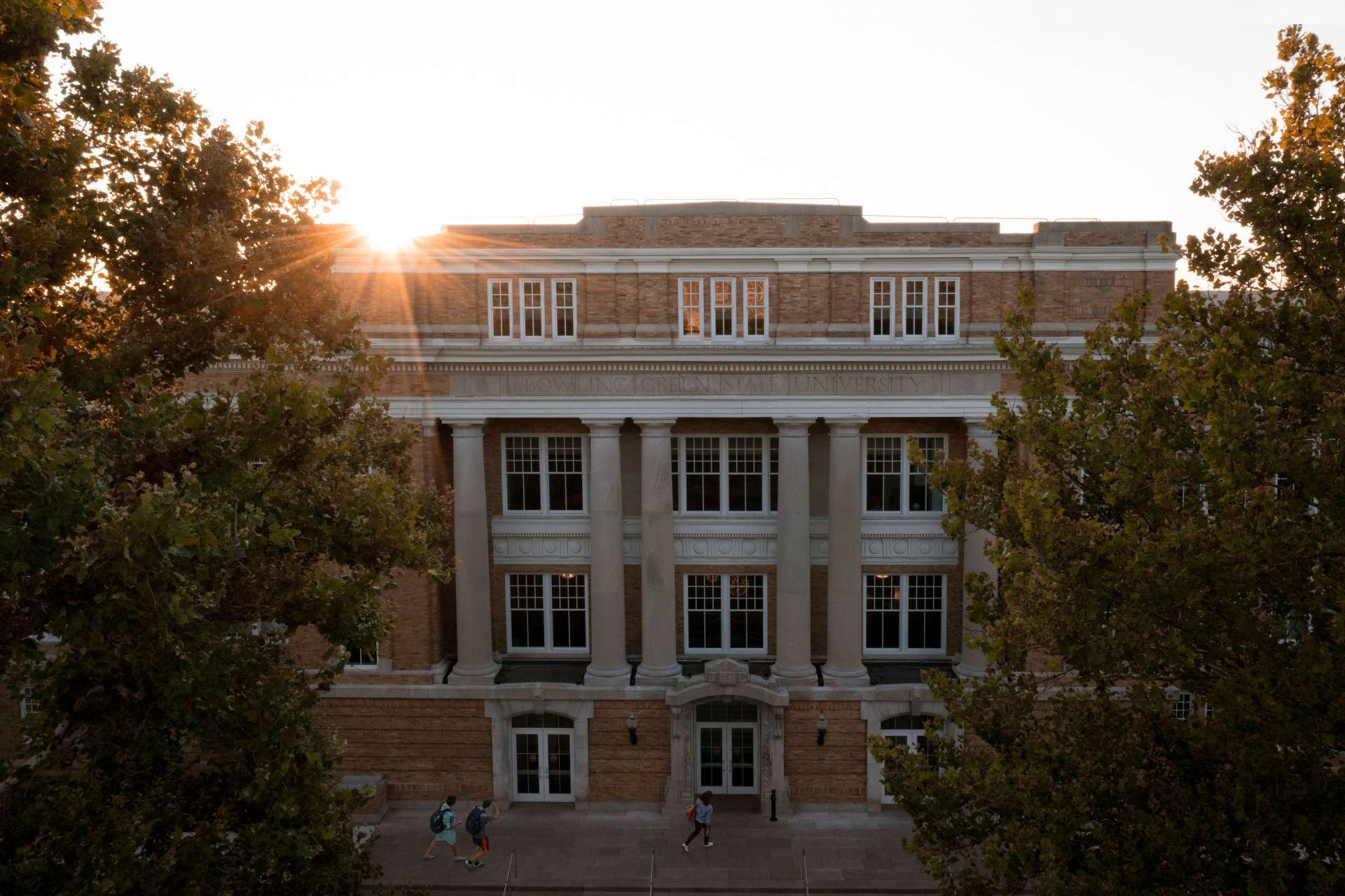
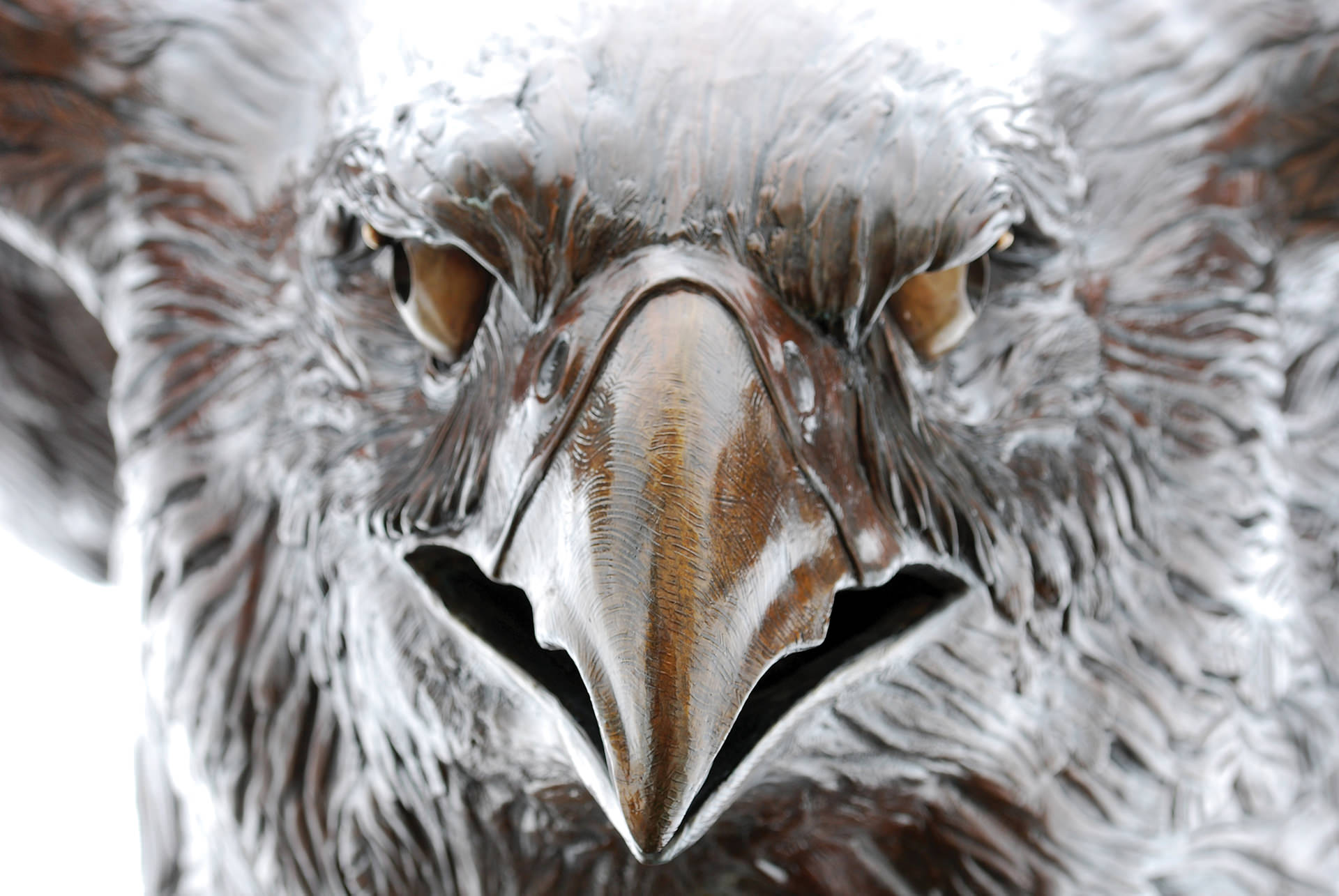
The Team Name
On Oct. 28, 1927, the nickname "Falcons" was originated for teams representing Bowling Green State University. BGSU, a struggling State Normal College in 1927, was doing its best to convey its value as a degree-granting institution. Common nicknames used by sports writers throughout the state were: "BG Normals", "Teachers", and the "BG Pedagogues". The current mascot was suggested by the sports editor of the Daily Sentinel Tribune, Ivan "Doc" Lake, a BGSU graduate. He thought the nickname was fitting, since it was indicative of a small but powerful bird. Its coloring represented the Bowling Green school colors, and like the athlete, the falcon is a bird that goes through a long period of training before battle.
The Alma Mater
Words and music by Edith M. Ludwig Bell '51, winner of the competition held in honor of the Golden Anniversary, 1960.
BGSU Alma Mater
Words and music by: Edith M. Ludwig Bell '51
Alma Mater hear us,
As we praise thy name
Make us worthy sons and daughters
Adding to thy fame.
Time will treat you kindly
Years from now you'll be
Ever dearer in our hearts,
Our University.
From your halls of ivy
To the campus scene,
Chimes ring out with gladness
From our dear Bowling Green.
When all is just a mem'ry
Of the by-gone days,
Hear our hymn dear Alma Mater
As thy name we praise.
Ay Ziggy Zoomba
Nearly 75 years ago, Gilbert Fox, an original SICSIC member, World War II veteran and musicologist wrote "Ay Ziggy Zoomba" and introduced the tune to Bowling Green. In 2013, the BGSU Undergraduate Student Government passed a resolution formally supporting the promotion of “Ay Ziggy Zoomba” to the status of an official fight song of the University.
Ay Ziggy Zoomba
Written by: Gilbert Fox
Ay Ziggy Zoomba Zoomba Zoomba
Ay Ziggy Zoomba Zoomba Ze
Ay Ziggy Zoomba Zoomba Zoomba
Ay Ziggy Zoomba Zoomba Ze
Roll along you BG warriors
Roll along and win for BGSU!
Forward Falcons
Composed by BGSU music instructor Dr. Wayne Bohrnstedt, 1949.
Forward Falcons
Words by: Sidney L. Freeman
Music by: Dr. Wayne Bohrnstedt
Forward Falcons,
Forward Falcons,
Fight for victory.
Show our spirit,
make them fear it,
Fight for dear Bee Gee.
Forward Falcons,
Forward Falcons,
Make the contest keen.
Hold up the fame of our mighty name, and win for
Bowling Green
Sounds of the Centennial
Composed by BGSU alumnus Ryan Nowlin '00, '04, winner of the BGSU Centennial Fanfare Competition.
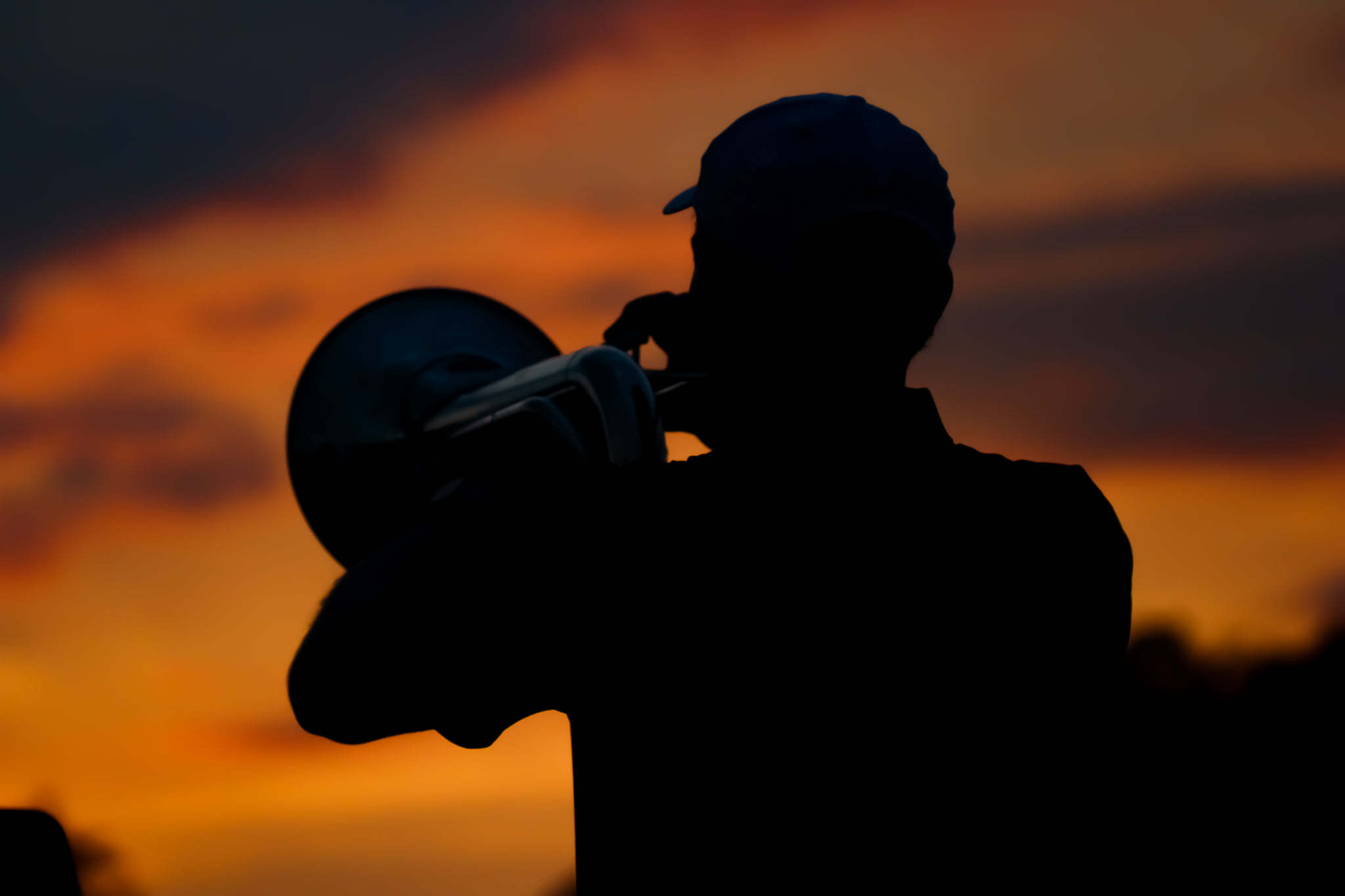
The Birth of Freddie Falcon
Freddie Falcon was born in 1950 in the minds of the members of the Alpha Phi Omega fraternity. The idea was to try and create school spirit at BGSU athletics events. On Jan. 16, 1950 at the BGSU vs. Ohio University basketball game, Freddie Falcon made his debut appearance introducing himself to the BGSU community. Under the head created from papier-mâché, a feathered cape and brown sweat suit outfit was Bob Taylor, BGSU's first Freddie Falcon.
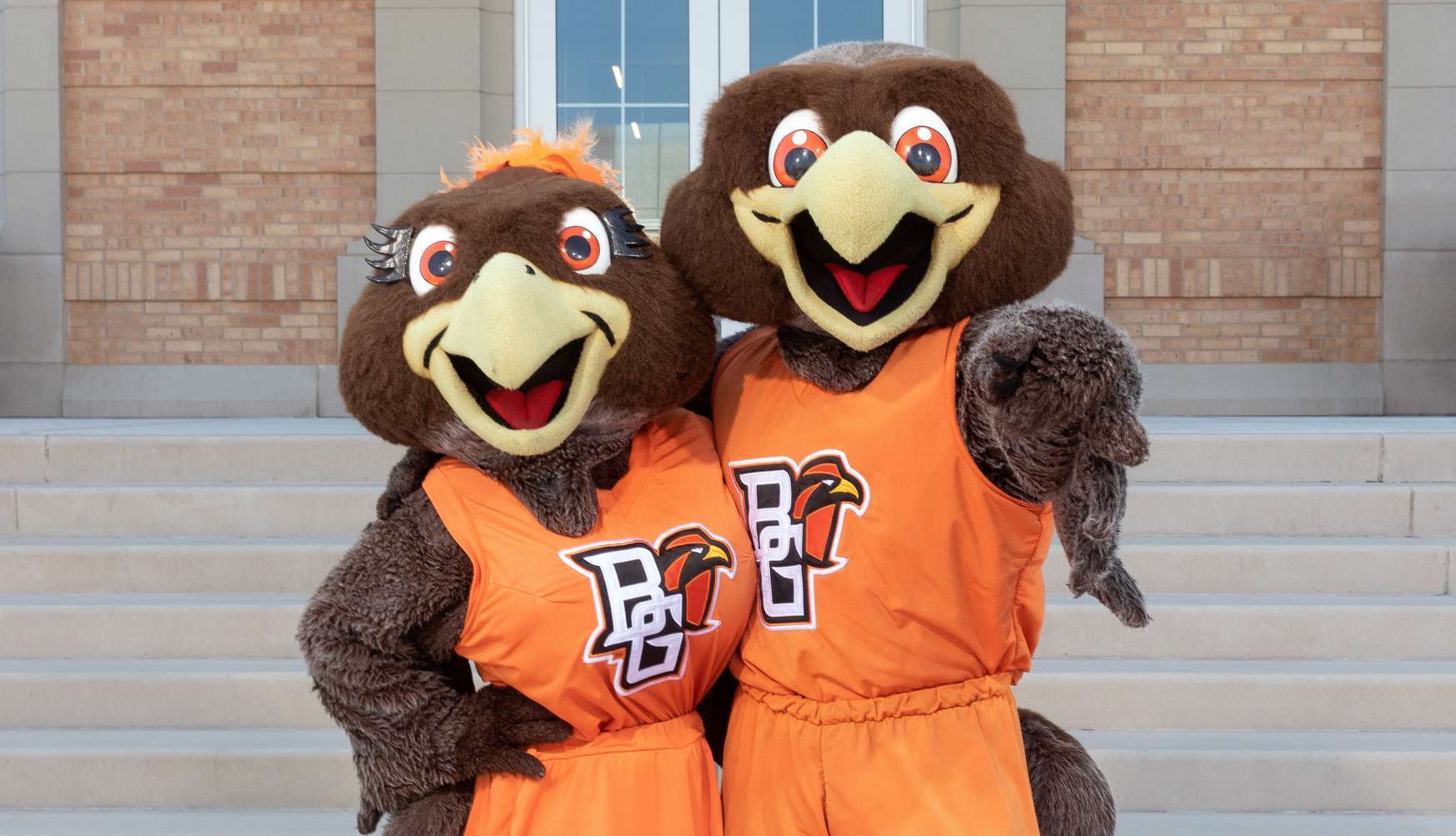
Frieda Falcon
Frieda first joined Freddie at BGSU on Feb. 25, 1966 as Mrs. Freddie Falcon. Contrary to what one might think, Mrs. Freddie Falcon was actually a male cheerleader in disguise. Frieda re-emerged in 1980 as Freddie's little sister and sidekick. Sue Sheard played the first official female Frieda during the 1980-81 school year. The spirited birds can be seen rooting for BGSU at football, men's and women's basketball, hockey and volleyball games, as well as just roaming around campus. The identities of the students who are selected to be Freddie and Frieda are not revealed until the end of the basketball and hockey seasons. Through the years Freddie and Frieda's appearances have changed several times, perhaps by accident or maybe on purpose. During the summer of 1950, the old Falcon's Nest (home to Freddie and Frieda) was located in a log cabin on the current site of the Bowen-Thompson Student Union. Apparently, some hungry mice got into the cabin and devoured Freddie's papier-mâché head right down to the chicken wire frame. The following year, Freddie's head had a new look. Instead of papier-mâché, he wore something resembling a rubber chicken mask. Freddie and Frieda have also been known to sport their trademark orange Chuck Taylor's, incorporated into the newest costume as comic-looking high tops with Falcon heads on them.
SICSIC
Across the Bowling Green State University campus, there are six masked students proclaiming school spirit through signs in black and red stating "SICSIC SEZ…" This strange group of students is SICSIC, a secret spirit organization.
SICSIC was created Oct. 5, 1946 at 12:45 a.m.. Seated in the dark room of BGSU's President Frank J. Prout's office these six young men, Richard Oliver Harig, Erwin Potts, Gilbert Fox, Earl Mott, Max Hofmeister and James Limbacher, anxiously waited to hear why they had been called to the President's office at such a late hour. Each one had received a secret letter earlier that day which told him to meet in the President's office at 12:45 a.m. and to destroy the letter as soon as he had read and memorized it. This letter bewildered the boys and piqued their curiosity. President Prout, Dick Harig, a senior Sigma Alpha Epsilon member, and Reverend James Stoner, the campus minister, had met earlier in the year to discuss the need for more school spirit and had decided that a secret spirit organization was exactly what the school needed. President Prout went through the yearbook and hand-picked the six men who would become the original "secret six." They had decided the new spirit organization would consist of two sophomores, two juniors and two seniors.
Unfortunately, President Prout was unable to attend the secret meeting that night, as he was in the hospital, but Harig and Stoner came in his stead. All six young men agreed to join the group and felt honored to have been chosen for the position. The group knew that they must have a unique and original name in order for their organization to stand out, and so SICSIC was created. The meaning of the name remains a secret, with only members and its alumni knowing what it stands for. The group also developed a constitution which laid out the standards of the organization and the rules governing its members. For instance, if the identity of a member is discovered before the proper time for unmasking, then that member must resign from the group and a new member will be put in their place.
SICSIC's unveiling occurred that same day at 3 a.m.. The student address system atop the Practical Arts Building (now Hayes Hall) announced the creation of SICSIC and asked the students to attend the football game which would occur later that day. The Secret Six gave the spirit organization a jump-start by placing signs across campus proclaiming, "SICSIC SEZ..." in black paint and in red paint, "BEAT," "MAUL," "DESTROY" the enemy, to encourage the athletes to defeat their opponents. In the spring, the seniors of the group, Harig and Potts, were revealed to the student body at the Annual Honors Day Ceremony. In secret, SICSIC tapped two members of the sophomore class to become new members of the secret six.
Today, SICSIC is still active on campus, posting their signs everywhere. Its members are seen attending athletic events, wearing their masks and overalls, cheering on the teams, and boosting the spirit of the student body. SICSIC has survived throughout the decades and has continued to advocate school spirit across the BGSU campus with their attendance at athletic programs and "SICSIC SEZ" signs.
Names of all graduated SICSIC members and honorary SICSIC members
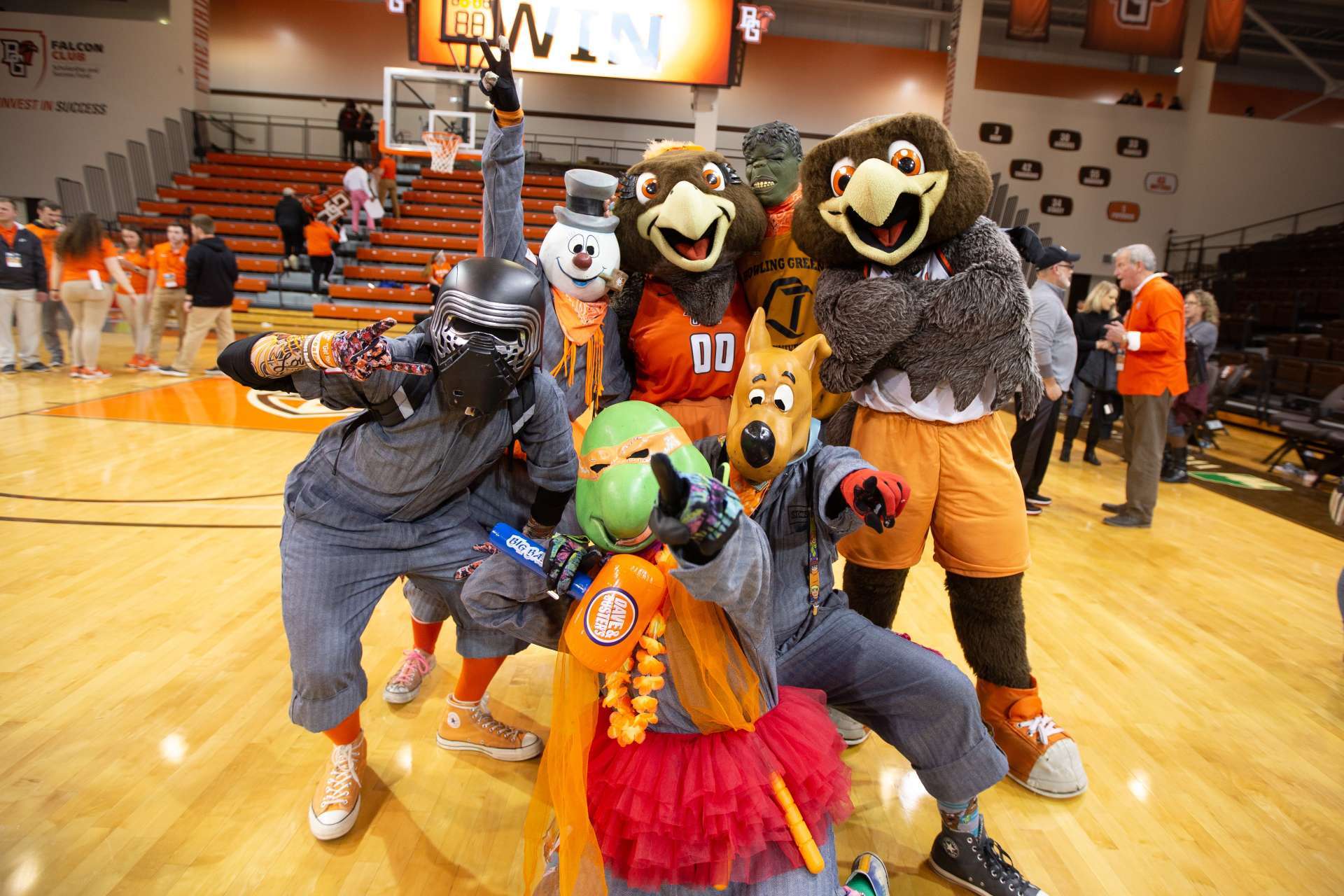
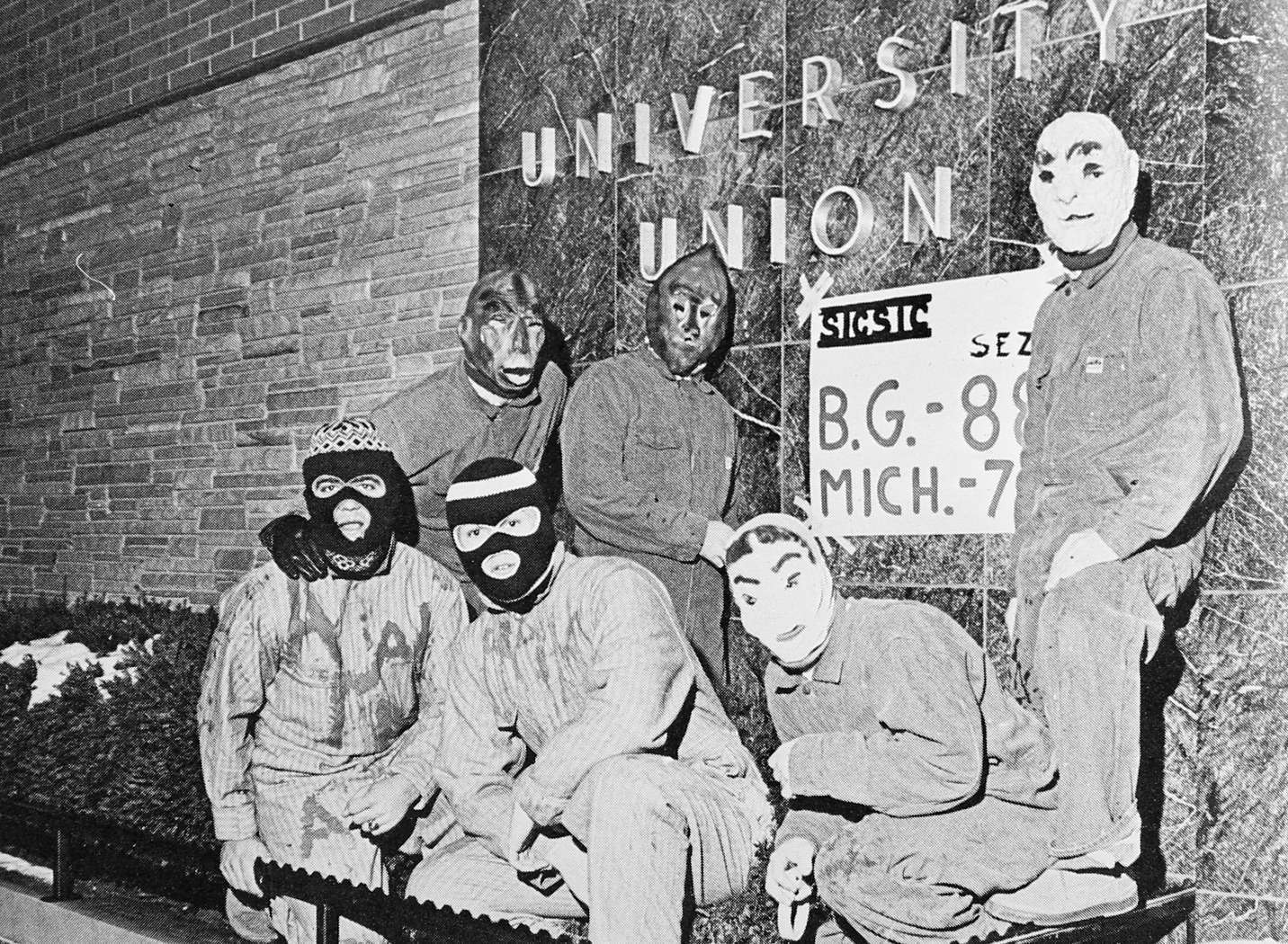
Falcon Flames
Many alumni met their soul mate while attending BGSU or married someone who also earned a degree from the University. Falcon Flames are couples who married and both individuals have BGSU degrees.
As of 2022, there are 11,420 Falcon Flames which includes 372 couples born in the 1930s and 40s who are still married.
The group is formally recognized as an alumni affinity group through the BGSU Alumni Association. Valentine's Day cards are sent to these couples which celebrate countless love stories and chance meetings that resulted in a lifetime of love.
In 2022 as BGSU celebrates 100 years of Homecoming, Falcon Flames are invited to renew their vows at with a special ceremony officiated by President Rodney K. Rogers.
The University Seal
The official University Seal was designed by Leon Winslow in 1914 to follow the format of the State Seal of Ohio. When faced with the problem of designing a seal for the new Normal College, Winslow suddenly remembered that William Creighton had felt the new Normal College was the rising sun of a great new institution of learning. He therefore decided to pattern his seal after the State Seal. It was, in contrast to the State Seal, divided into four parts, the mountain range, the brilliant sun, the bundle of 17 arrows representing Ohio's rank in the Union, and the sheaf of wheat to signify the great agricultural industry of the state. Around the outside of the main design were printed the words "Bowling Green State Normal College."
Several changes in the lettering have taken place in the seal, as the State Normal College became a state college and finally a university. In January 1958, Glenn Christian, University purchasing officer, made a few minor revisions in the seal, including the addition of the buckeye, the state tree and the carnation, the state flower. He also made minor changes in the sun's rays, the fringe lines and the type of lettering used.
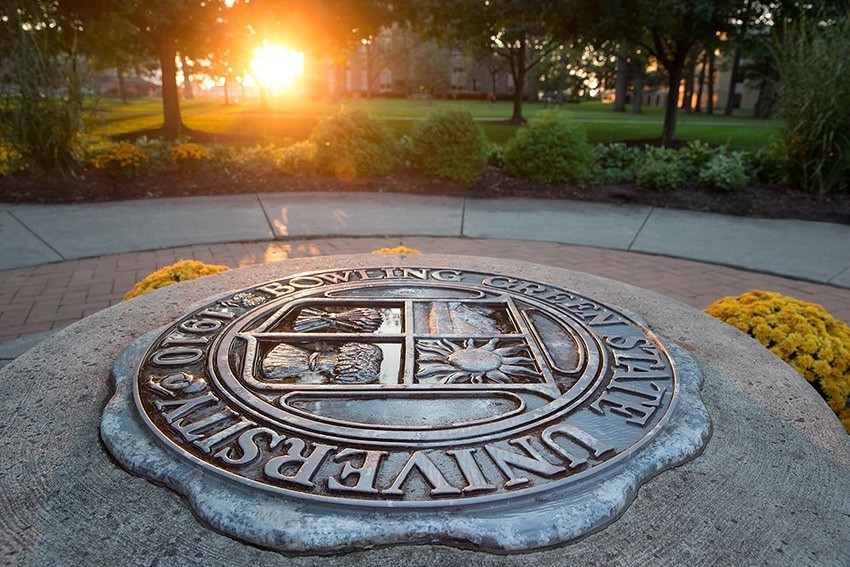
Seal Traditions
If you stand on the seal at midnight and kiss your sweetheart, you will soon be married.
If you and your sweetheart are holding hands and let go as you walk around opposite sides of the seal, you will soon break up.
If you pass to the right of the seal, you will do well on your next test.
If you pass to the left of the seal, you will fail your next test.
The University Mace
The Mace, used as a weapon in medieval times, is employed today on many university campuses as a symbol of office. The Mace of the President of Bowling Green State University bears symbols and figures representing three related categories of human culture: areas of learning, the vicissitudes of culture, and the waxing and waning of human life.
Designed and created by Harold Hasselschwert, assistant professor of art, the mace weighs six and one-half pounds and is 27 inches long. The mace is engraved and enameled silver, creating a moire´effect as a backdrop for figures representing the six branches of learning: drama, art, literature, music, science and commerce.
Approximately 500 square inches of silver were used in the mace, which is adorned with ancient and medieval symbols. At the base are engravings representing the areas of learning: jester's staff, quill and scroll, lyre, palette and brushes, the atom and the balance.
A silver pendant containing the inaugural symbol and University seal is worn by the President of Bowling Green State University on ceremonial occasions.
The medallion was created in 1964 by Dr. Carl D. Hall, BGSU professor. It depicts a “tree of knowledge” and symbolizes the University’s growth at that time.
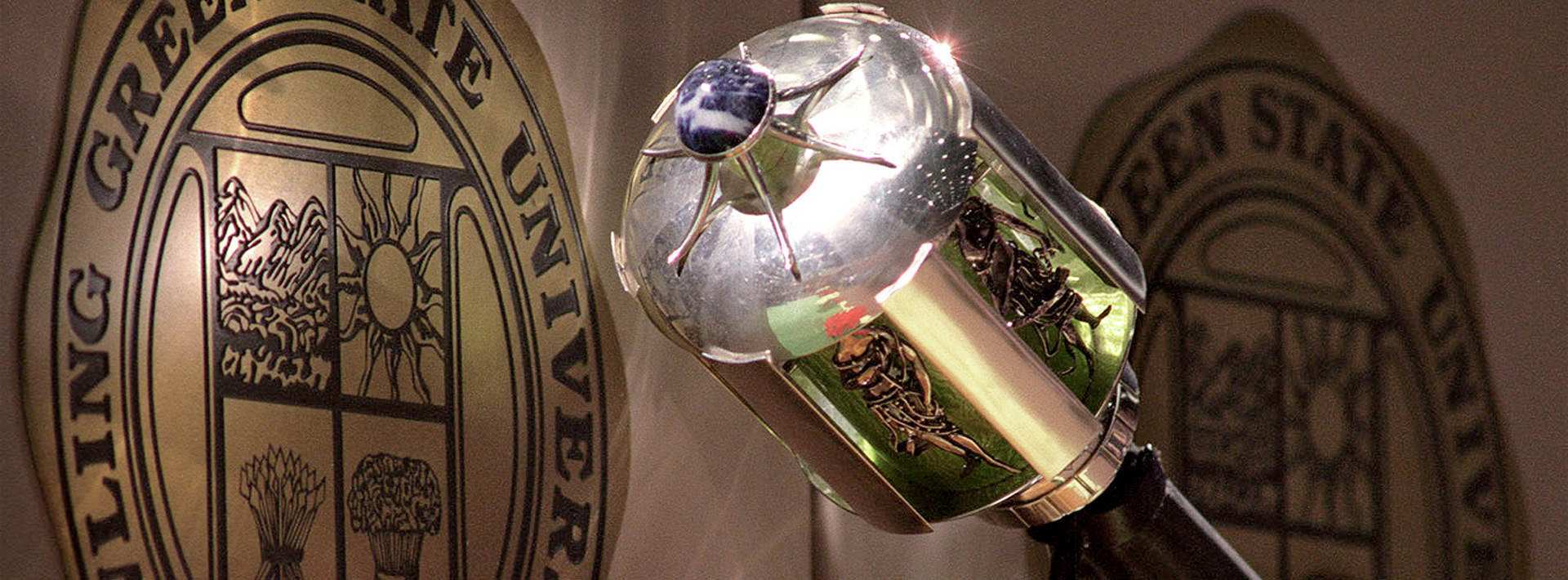
Updated: 01/22/2024 10:00AM
